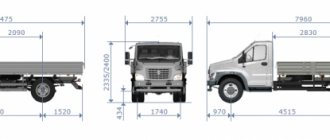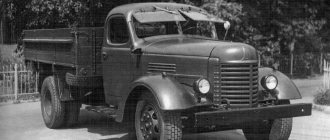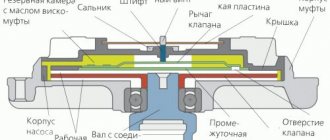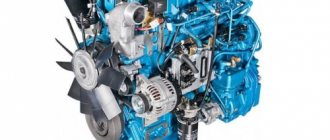The ZMZ 406 engine and carburetor replaced the 402 model and was initially intended during the development process for installation on the new family of executive cars GAZ-3105. However, due to the closure of the project for a new luxury car, the target group of consumers was changed and the plant began supplying the engine to the produced passenger cars of the GAZ family.
As automotive production developed, the engine began to be installed on light-duty trucks of the Gazelle family and all-wheel drive vehicles produced by the Ulyanovsk Automobile Plant.
The engine was designed from scratch. The basic prototype was a Swedish engine, the H series, which was installed on SAAB-9000 cars. The carburetor version has factory indices ZMZ −4061.10 and ZMZ-4063.10
The resulting in-line gasoline four borrowed double camshafts and an electronic ignition distribution system as a design solution. For 1993, this was a revolutionary solution for the Russian automobile industry. ZMZ was the first to use the DOHC design for supplies to Russian car factories. Although by 1997, when deliveries to car factories began, the 406 engine already had an outdated design, compared with the same Saab.
Copying technological solutions did not allow the actual parameters of the prototype to be taken from the engine. And instead of 150 hp and 210 Nm of thrust like the prototype, the brainchild of the Zavolzhsky Motor Plant with a carburetor produced 100 hp. and 177 Nm with the same volume of 2.3 liters. The technical characteristics of the original were achieved only after additional modification of the engine with the installation of a fuel injection system.
ICE ZMZ-406 carburetor was installed on versions of light trucks and vans produced by GAZ OJSC until 2006. GAZ 3302, on which a 406 carburetor was installed, was perhaps the most common model due to its relative cheapness.
Also, the carburetor engine of this family was installed on passenger cars of the Volga family. This engine provided the minimum cost option for the car.
ZMZ 406 engines for Gazelle
The ZMZ 406 engine was first installed on the Volga car in 1994 as a prototype, and was developed even earlier.
Since that time, the engine has had a huge number of different modifications; it has established itself as a reliable unit with good technical features. The first Gazelles, which went into production in 1994, were first equipped with the well-tested ZMZ 402 engine. This is what the ZMZ 406 engine installed on a Gazelle looks like
But the carburetor internal combustion engine was still rather weak for a one and a half ton truck, and it had another setback - the 402 consumed a lot of fuel, especially under load. Therefore, since 1997, GAZ 3302 cars began to be equipped with a ZMZ 4063 carburetor engine with a volume of 2.3 liters and a power of 110 hp. With.
GAZ 31 1996, 150 l. With. — tuning
Cars for sale
GAZ 3102 Volga, 1994
GAZ 3102 Volga, 1991
GAZ 3102 Volga, 2005
GAZ 3102 Volga, 1999
Disassembly and assembly of K151D
Main characteristics of the 1.6 engine on Lifan Solano
All repair work on the carburetor unit is carried out in a dry room, on a clean table, where there are no foreign objects (only the necessary tools and devices). When disassembling we remove:
- top cover (held on by seven screws)
- to completely dismantle it, it is also necessary to disconnect the telescopic suction rod;
- then we remove the top gasket, it can be replaced in any case, unscrew the side plug screw, remove the axle, remove the float from the chamber;
- the float must be without external damage and without gasoline inside (to determine this, you need to shake it);
- we remove the needle of the locking mechanism, it can be removed here freely;
- Next, we unscrew the GDS (main dosing system) jets; the fuel jets are located at the bottom, inside the chamber, the air jets are at the top;
- each jet has its own marking, and when replacing them, you need to install strictly in their places those parts that correspond to the parameters;
- Next, we remove the accelerator pump nozzle, the primary/secondary chamber diffusers (we pry them off very carefully, trying not to damage them anywhere, and there are also small gaskets installed there);
- unscrew the four screws of the accelerator pump diaphragm housing; if the diaphragm is not even torn, but has lost elasticity, it is better to replace it immediately;
- turn the case over, unscrew the two screws securing the lower part with the throttle valve, the screws are located almost in the middle;
- between the housings there are two thin and one thick gaskets, it is also advisable to change them immediately;
- All that remains is to unscrew the three screws securing the forced idle economizer housing (EFS), and at this point the main disassembly can be considered complete.
If you need to change the transition system jets, then you should also unscrew the side plugs.
When replacing parts using a repair kit, under no circumstances should the jets be mixed up; they have a certain calibration, and if they are installed incorrectly, the engine will operate unstably and fuel consumption will increase. Two screws in the main body (pictured below) are adjusting (one is the needle of the accelerator pump in the drainage channel, the second is the valve regulator of the same system, there is a ball inside the channel). The side screws located next to the diffusers are the XX air jets (main and additional (second)) and the transition system.
Engines of the ZMZ 406 family on the Gazelle
Design and characteristics of Binar engine preheaters
The ZMZ 406 engine had many advantages over the 402nd internal combustion engine:
- It had good dynamics and power;
- Didn't have any huge problems with oil consumption. At least, oil flowed through the rear main oil seal very rarely, unlike ZMZ 402;
Rear main oil seal on the ZMZ 406 engine
Rarely needed repairs. The main problem with the 406s was the timing chains, which had to be changed every 70-100 thousand km.
At the moment, many owners of old versions of Gazelles with the 402 engine have already replaced the internal combustion engine with a more modern power unit. Moreover, car owners install not only the carburetor version of ZMZ 4063.10. You can also install a more modern ZMZ 405 injector, but additional changes will be required to the electrical part of the car.
Crankshaft
Cast from cast iron with subsequent processing and hardening of the surface of the journals with high frequency currents. It is installed in the block on five main bearings.
The movement of the crankshaft according to the axis is limited by corkscrew half-rings, which are located in the flow grooves of the support and the cover of the third main bearing. There are eight counterweights on the shaft. A flywheel is attached to the rear of the shaft, in the hole of which a spacer sleeve and a rolling bearing of the gearbox input shaft are pressed.
Installation of ZMZ 405 instead of UMZ 4216
Engine 1ZZ Engine characteristics
Many Gazelles are still equipped with a 123-horsepower UMZ 4216 internal combustion engine. It’s a shame, but the engine is not reliable, and there are many complaints about it. It often happens that car owners, having suffered with UMP, decide to rearrange the power unit.
First of all, the reliable and proven ZMZ 405 motor is considered as a replacement; various companies offer this replacement service.
It is not difficult to rearrange the motor with your own hands. The replacement scheme and principle are practically no different from the installation scheme of the ZMZ 406 engine instead of the ZMZ 402. Paradoxically, the vaunted Cummins turbodiesels are sometimes removed and the ZMZ 405 is installed instead. Do-it-yourself trimmer repair stihl fs 38. Cummins - in general It’s a good motor, but with Russian diesel fuel its service life before major repairs is significantly reduced.
MZ 405 engine ready for installation on Gazelle
Various commercial services are also offered for replacing Cummins with ZMZ 405. And this means that such work is in demand.
Repairing a diesel engine costs a pretty penny; a 405 engine is much cheaper. Do-it-yourself engine repair ZMZ 406, ZMZ 405, ZMZ 409 in the garage, grind the block, valve seats, chipped valve seats. In addition, many spare parts for the Zavolzhsky motor can be bought used - they sell any spare parts through advertisements on Avito, and there are more than enough offers.
Electronic ignition system
The completely Russian development of electronic filling is now practically unified and different versions of this electronic unit can be installed. It should be noted that the software must be installed taking into account the technical characteristics of a particular engine.
The Gazelle with the 4061.10 engine was designed to operate on 76 gasoline and the 406 engine had a reduced compression ratio; accordingly, firmware was required to ensure stable operation of the engine on this fuel.
Electronic ignition units for power units are not interchangeable with other series of engines. Those. The block for 405 is not suitable for installation on a gazelle equipped with a 406 engine.
The procedure for connecting pipes to the K151D carburetor
The carburetor unit (CU) in the K151D modification is identical in appearance, design and many components to the K151S model, which was installed on ZMZ-402 engines. The device itself is not very complicated, moreover, it is easy to install, but some drivers (car owners) have difficulties connecting the hoses, since there are quite a lot of them.
Let's dwell on this issue in more detail, consider with the help of diagrams (photos) where the pipes are connected, and what each of the fittings is needed for:
- in the first picture: No. 1 – for the main fuel supply hose, No. 2 – for the “return” hose, No. 3 – for the crankcase ventilation pipe, No. 4 – for connecting the solenoid valve (EMV) of the idle speed economizer;
- in the second picture: No. 5 – for connecting to the economizer EMC (second outlet), No. 6 – for connecting to the exhaust gas recirculation valve (exhaust gas).
The first two fittings are the most important, designed to connect the hoses for supplying and discharging excess fuel; they cannot be confused with each other, since the “return” is equipped with a valve, and fuel will not flow through it into the CU from the gas tank, and the engine will not start. Number three connects the pipe for the forced removal of crankcase gases from the engine, which fall under the influence of vacuum into the intake manifold. Since this outlet is located in the lower part of the housing, crankcase gases do not enter the carburetor assembly itself.
Numbers 4 and 5 (they are in different pictures) are outlets with hoses with which the EMC is connected to control the XX (idle) economizer; this valve often breaks (although the fuse may also fail). In addition, it is believed that it does not play a big role, has practically no effect on fuel economy, and it is often turned off by looping the bends together with a tube. You cannot leave the fittings unconnected or turn them off - the engine will stall, operate with significant interruptions, and lose power.
Number 6 is the most “optional” of all the taps, since the recirculation valve only affects the environmental friendliness of the exhaust gases, moreover, this device is not always installed on the car. If desired, fitting No. 6 can be plugged, but it is not at all necessary; if it is left open, nothing will change and will not affect the operation of the internal combustion engine in any way.
Ways to reduce the amount of fuel consumed
Having considered all the points that in one way or another affect the fuel consumption of the Gazelle 406 carburetor, we should highlight some methods by using which you can reduce the amount of fuel consumed. Necessary:
- adhere to the maximum permissible driving speed;
- in addition to the gasoline engine, install an LPG, which will allow you to alternately use two types of fuel;
- always maintain the car in technically sound condition;
- avoid malfunctions, check all components and parts of the fuel supply system for cracks and breaks;
- check the fuel tank for integrity, prevent leakage of fuel and lubricants;
- carry out tuning of the Gazelle after a certain number of kilometers stated in the technical passport.
VolgaGazelle ZMZ-406 engine tuning
Forcing ZMZ 406
The first option for increasing engine power, according to tradition, is atmospheric, which means we will install shafts. Let's start with the intake, install a cool air intake, a larger volume receiver, saw the cylinder head, modify the combustion chambers, increase the diameter of the channels, grind, install the proper, lightweight T-shaped valves, springs 21083 (for evil variants from BMW), shafts (for example OKB Engine 38/38). There is no point in turning a standard tractor piston, so we buy forged pistons, light connecting rods, a lightweight crankshaft, and balance it. The exhaust is on a 63 mm pipe, direct-flow, and we set it all up online. Output power up to approximately 200 hp. and the character of the engine will receive a pronounced sporty color.
ZMZ-406 Turbo. Compressor
If 200 hp. you want childish fun and want real fire, then supercharging is your way. In order for the motor to withstand high pressure normally, we will install a reinforced forged piston group under low coolant
8, otherwise the configuration is similar to the atmospheric version. Garrett 28 turbine, manifold for it, piping, intercooler, 630cc injectors, 76mm exhaust, DADDTV, tuned in January. At the output we have about 300-350 hp. You can change the injectors to more efficient ones (from 800cc), install a Garrett 35 and blow until the engine falls apart, this way you can blow out 400 or more hp. As for the compressor, everything is similar to turbocharging, but instead of a turbine, manifolds, pipes, intercooler, we install a compressor (for example, an Eaton M90), tune up and go. The power of the compressor options is lower, but the engine is trouble-free and pulls from the bottom.
Motor RATING: 3
Gazelle
Model ZMZ 40524.10 is a gazelle carburetor known to everyone. The car brand “Gazelle” is one of the most popular and affordable trucks in Russia, which were originally intended for transporting not very large loads. Due to the huge number of such machines, we will consider several nuances of different gazelle systems. For example, a microprocessor ignition system, which is installed on the 406 model.
If the driver claims that his car makes some popping noises, jerking noises and loses its power. In this case, the power system, engine and ignition system should be checked. We checked the carburetor with a gas analyzer not during the operation of the 1st and 2nd chambers, cutoff, enrichment and during idling and did not find any violations. Next they check the engine. When checking the compression, no problems were identified, but the next time deviations from the norm were detected. It was concluded that the jerks and pops that the driver did not like were due to the jumping of the teeth of the upper chain.
Carburetor ZMZ 406 series
What to do if a gazelle loses power?
From the very beginning, you need to check how the diagnostic circuit and the on-board diagnostic system function, because when the travel image mode is activated, a malfunction code of 12 should be obtained. To read the code, the 10th and 12th contacts of the diagnostic block must be closed. Using a diagnostic toaster, engine sensor parameters are measured and then compared with typical values for average engines. The most common reason for a decrease in car power is contamination of the tube that connects the intake manifold and the pressure sensor.
Gazelle ignition system
The microprocessor ignition system ignites the working fluid in the cylinders and sets the required vehicle ignition timing for all engine modes. The ignition system performs the function of regulating the operation of the forced idle economizer. Thanks to the ignition system, engine operation becomes more economical, compliance with all exhaust gas toxicity standards is monitored, detonation is eliminated and the vehicle's power is increased. If we compare the classic system with this one, then this ignition system is much more reliable and durable. Here only the spark plugs can wear out.
How does diagnostic mode work?
When the ignition system is turned on, the indicator light begins to light. At that very moment, the diagnostic system begins to work. If the system is working properly, the light stops lighting, but otherwise it continues to light. That is, an extinguished warning light indicates that the ignition system is absolutely working.
Carburetor ZMZ 406 series
Why does the 406 engine sometimes not start during a freeze?
The most common reasons why the 406 engine does not start:
- Poor quality oil;
- The battery is not powerful enough, which prevents the engine from starting;
- Faulty starter;
- Misregulated ignition system;
- Poor quality gasoline;
- Failure to supply gasoline.
How to adjust the carburetor?
- Disconnect the choke actuator cord;
- Remove the air filter and carburetor cap;
- Check the level of the float chamber, it should be below 3 centimeters from the edges;
- Remove the plug from the float rod;
- Make sure the valve seal ring is tight;
- Install the carburetor top;
- Install the choke cable and air filter;
- Screw in the idle speed adjustment screw all the way, unscrewing it five turns. Carry out the same actions with the quality screw, but unscrew it three turns;
- Start the power unit;
- Let it heat up to 90⁰;
- By rotating the operational adjustment screw, select the crankshaft speed, about 700 rpm;
- Press the accelerator pedal and release quickly. If the engine stalls, increase the frequency;
- Stop by a car dealership and adjust the CO and CH of the engine.
Adjustment
Fuel consumption directly depends on the adjustment, even if the carburetor is absolutely working.
There is only one external adjustment in the device - idle speed. How to do it correctly:
- We start the engine and warm it up to a hot state, then perform adjustments at idle speed;
- We unscrew the quantity screw (a large screw with a spring) and the quality screw until the engine reaches maximum speed;
- By evenly tightening both screws, we find the position when the engine starts to work with minimal interruptions;
- Using the quantity screw we set the speed to a slightly higher speed, at this point using the quality screw we achieve stable operation of the motor, but at the same time we need to try to keep the quality screw unscrewed to a minimum (as far as possible);
- Having adjusted the quality, turn the quantity screw until the optimal idle speed is obtained (700-750 rpm).
If there are malfunctions in the carburetor or engine that affect the stability of idle speed, there is no point in adjusting the idle speed - you must first fix the problem.
There are many reasons for unstable operation of the internal combustion engine - from a simply non-functioning spark plug or a piercing high-voltage wire, to a burnt-out exhaust valve or piston.
If you remove the carburetor housing cover, you can adjust the gasoline level in the float chamber. Adjustment is made by bending the tongue on the float.
UMZ engines era 92x92
Of all the engines currently installed on the Gazelle, the Ulyanovsk UMZ421 has the longest life. It is based on the Volga GAZ M-21 engine, which was put on the assembly line back in 1956. Of course, during this time it was modernized several times, but the inter-cylinder distances of the block, the diameters of the main and connecting rod journals still remained unchanged. But by and large: connecting rods, camshaft and crankshaft, oil pan, and the external appearance of the block cannot be confused with any other engine. And it all started in the late 60s and early 70s with the production of “loaves” and “tadpoles” UAZ-451 and UAZ-452, as well as all-terrain vehicles UAZ-469, initially they were equipped with a pure Volgov engine. Due to the loads associated with off-road driving, as well as the considerable mass of the gearbox and transfer case assembled together, the flywheel housing cracked and shattered in half. Several ventilation holes served as stress concentrators, and we learned how to modernize the crankcase on the ZMZ-24 engine. At the same time, instead of coarse and fine oil filters (a “pan” with a cardboard replaceable element connected to the block by frequently torn hoses), a full-flow oil filter from a Zhiguli was installed. This immediately increased the service life of the engine, and this solution turned out to be more successful than even on the ZMZ-24, although further modernization was carried out with an eye on the Zavolzhsky Motor Plant. They weren't competitors then. The crankshaft was changed - the main liners became the same width, and their covers became cast iron, the temperature compensation slot was removed from the piston skirts, a closed crankcase ventilation system was introduced, and the collectors were made “round” in cross-section. The next modernization took place in the late 80s; in the early 90s, the engine received the designation UMZ-417. By this time, in the Volga region they switched to the production of ZMZ-402 engines, and the ZMZ-24 block head went to the Ulyanovsk residents, it became possible to install two-chamber carburetors, and the power increased. We installed an oil pump with increased performance, with a larger gear diameter - the oil pressure became more stable in all modes. Thanks to this, “advanced” repairmen stopped putting a nut under the pressure reducing valve spring, and the motor turned out to be less sensitive to wear in the shaft joints.
All this time, somewhat outdated design solutions and technologies from ZMZ were transferred to the Ulyanovsk motor plant, and it lagged behind in modernization. But on the UMZ-417 engine, Ulyanovsk designers still overtook their mentor colleagues, given the low quality of our rubber products, they moved the front crankshaft oil seal to the outside of the cover.
Carburetor repair K151D
Repair of the K151 carburetor includes disassembly and reassembly, washing and purging, replacement of parts, subsequent adjustment, mainly during repair work the following are replaced:
- jets (both air and fuel);
- sprayer (“spout” or “elephant”) of the accelerator pump;
- gaskets;
- float chamber locking mechanism (needle and seat included);
- quality screw;
- diaphragm.
If there is no need to overhaul the unit, repairs can be made without removing it; for the convenience of buyers, parts are often sold in repair kits.
The fine mesh filter is also replaced; it is located in the housing of the fuel supply and return fittings.
If a carburetor is being overhauled, the entire unit is disassembled to the ground, all channels are washed and blown, including the removal of large and small diffusers.
Engine 406 - description
The ZMZ 406 internal combustion engine is produced at the Zavolzhsky Motor Plant, which is the main supplier of components for the Gorky Automobile Plant (GAZ). The ZMZ enterprise is also engaged in the manufacture of the 405 model engine. These two engines have become the real pride of the Zavolzhsky plant. In their design and technical data, they differ somewhat from each other. But still, almost every car enthusiast knows their operating principle.
What cars is this engine model installed on?
Most often, the engine of the 406th model was installed on the Volga model 31105, as well as on the well-known Gazelkas. Moreover, since 2003, the Gorky plant has completely updated the technical characteristics of all models of these trucks. From that moment on, the 402 engines completely went out of production and were no longer installed on any modern truck. They were replaced by two new units - ZMZ 406 and ZMZ 405.
406 engine - characteristics and description
This engine model went into mass production back in 1997. But, despite this, GAZ 3302 GAZelle cars until 2003 were equipped with only 402 engines. The new product ran on 92 gasoline. The main detail that distinguishes it from other models is fuel injection, which was first developed by engineers at the Zavolzhsky plant. Over its long period of existence, the engine of the 406th model has gained enormous popularity and has become one of the most common in Russia. It gained such popularity due to its reliable design and economical fuel consumption.
History of creation
When operating the 405 engine, significant shortcomings were noticeable: on hot summer days, the Volga and Gazelle simply overheated and boiled (probably everyone saw such a phenomenon when there was an empty plastic bottle under the hood of a Gazelle). This indicated flaws in the cooling system. Many drivers installed a three-section radiator in place of the serial two-section one, but still the engine sometimes made itself felt. The engineers of the Zavolzhsky Motor Plant understood that they could not go on like this, and began to develop a new injection engine, the ZMZ 406. It was not developed from scratch - its entire design was reminiscent of the 405 engine. But now all the shortcomings have been taken into account and are not included in the new 406 engine (injector).
What are the changes in these two models?
So, the very first difference of the 406 engine is the presence of an injector. The carburetor had its drawbacks and was unreliable. The power of the new product was 145 horsepower. Working volume - 2.4 liters. The unit has significantly lower fuel consumption and is very easy to start in winter. This engine is also distinguished by its high reliability, which cannot be said about the 405 model. Actually, these are the main advantages because of which many motorists choose the 406 model engine.
Major renovation
Approximately every 200-300 thousand kilometers this engine requires major repairs. This procedure costs much more than repairing ZMZ 402 and 405 (approximately 30-40 thousand rubles). And all because of the complex design of the unit. Therefore, when operating a GAZelle, you should remember that in about 3-4 years it will require significant repair costs.
see also
Comments 20
Fan from a Lada? :) from a 6?
I'm thinking about it. A lot of hassles with the installation?
It's 30 minutes. You just need to buy longer bolts for fastening.
What did the fan itself connect to? (the wires themselves)
Hello, read it, I basically described there what can be done, and just some information about this will be useful. www.drive2.ru/cars/gaz/31/31105/veter-150/journal/
Hello, thanks for the information.
Isn’t that a bad idea, you need to think about it, the main thing is that there is no extra load on the pump
Install a fan like mine. 1500 money.
406 engine, finally a fire engine =)
I change the filter when changing the oil, in the fall and spring. The hose must be replaced.
Do you change the air filter often? It probably quickly becomes dirty and the corrugated hose is not good, it creates additional resistance at the inlet.
I also have a button like this.
And I just made a forced button to turn on the EV
Why is there a second fan? Is one really missing?
On hot days in traffic, the fan hummed without stopping, but with additional everything was as always
The fan is constantly running in traffic jams - this is normal. The additional fan is complete nonsense. On the highway the engine will be too cold. I'm not even talking about winter time.
I took it off for the winter and haven’t installed it yet. But the second fan is a topic. On Volgas with 402, many have two fans.
Don't compare the scrap 402 with the divine 406. Set the thermostat to 87 degrees, throw out the oil cooler, fill it with synthetics and your car will be all-weather.
The fan is constantly running in traffic jams - this is normal. The additional fan is complete nonsense. On the highway the engine will be too cold. I'm not even talking about winter time.
Clutch gas 3221
The clutch on the car is single-plate, dry, friction, the drive is hydraulic.
Figure 4. Clutch
1 – master cylinder of the clutch release drive; 2 – clutch housing; 3 – flywheel; 4 – friction linings of the driven disk; 5 – pressure disk;
6 – support rings; 7 – pedal spring; 8 – diaphragm spring;
9 – clutch release bearing; 10 – master cylinder rod;
11 – pedal; 12 – gearbox input shaft; 13 – foam rings;
14 – release clutch; 15 – fork ball joint; 16 – casing; 17 – fork;
18 – working cylinder rod; 19 – connecting plate; 20 – working cylinder; 21 – bleeder fitting; 22 – damper spring; 23 – driven disk.
The clutch consists of an aluminum housing, a release clutch with a bearing and a fork, a drive disc assembly (basket), a driven disc, a master and slave cylinders, connected to each other by a hose and tube.
The drive disk (basket) consists of a casing in which a diaphragm spring, support rings and a pressure disk are installed. A spring attached to the casing presses on the pressure disk with its edges.
The driven disk consists of a hub with a splined hole and two disks, one of which has leaf springs riveted to it. Friction linings are attached to them on both sides.
Leaf springs with bends contribute to a better fit of the disc and additionally smooth out jerks in the transmission when the clutch is engaged.
For a smoother transmission of torque when starting the car or changing gears, damper springs are installed in the disk windows.
The driven disk is pressed against the engine flywheel by the pressure plate of the basket. Through friction linings that increase friction, torque is transmitted to the driven disk and then to the input shaft of the gearbox, to which the driven disk is connected by a splined connection.
The clutch release drive is used to temporarily disconnect the engine from the transmission. When you press the clutch pedal, the clutch master cylinder piston moves forward.
The displaced liquid enters the working cylinder through a tube and hose, pushing out a piston with a rod.
The rod acts on the shank of the fork, which rotates on a ball joint, with the other end moving the clutch release clutch along the gearbox bearing cover. The clutch bearing presses on the ends of the diaphragm spring petals. When deformed, the spring ceases to act on the pressure disk, which in turn “releases” the driven one, and the transmission of torque stops.
On the outside, the clutch mechanism is covered with an aluminum housing. The crankcase is attached to the engine cylinder block with six bolts and two reinforcements. On the other side, four studs are screwed into the crankcase to secure the gearbox.
The crankcase has a seat for the clutch slave cylinder and a window for installing the fork. To increase rigidity, a reinforcement is installed on the lower part of the clutch housing.
Pistons
They are cast from aluminum alloy and have grooves for two compression rings and one oil scraper ring. During operation, the piston crown is cooled by oil through an oil nipple in the upper end of the connecting rod.
The spherical working surface of the upper compression ring has a layer of chrome coating, which facilitates better grinding of the ring. The second element is coated with a layer of tin. The oil scraper ring is of a combined type; it consists of an expander and two steel discs. The piston is attached to the connecting rod using a pin fixed to two corkscrew rings.
Replacing a carburetor with an injector on a ZMZ-4063 engine
In order to improve technical characteristics, quite often Gazelle owners replace the carburetor system with an injector, although this pleasure is not cheap. For such a modification it will be necessary to purchase additionally:
- air flow sensor;
- electric fuel pump;
- other wiring for the engine;
- intake manifold (receiver) assembled with dampers;
- air pipes;
- DTOV (ambient temperature) and TPS (throttle position) sensors;
- fuel rail with injectors and fuel pressure regulator;
- the engine control unit;
- front small engine cover;
- both camshafts (differ in cam profile);
- fuel filter;
- air filter housing (“can”) assembled with a filter element;
- idle speed controller.
You may also need various small things, such as gasoline hoses, clamps, fuses, gaskets, fuel filter bracket, etc. The work here is labor-intensive, but the end justifies the means. The advantages of an injector over a carburetor are significant:
- the engine receives a significant increase in power;
- no need to constantly struggle with adjusting and cleaning the carburetor;
- You can install HBO of almost any generation, except the first.
Some injector spare parts are expensive, but it is not necessary to purchase them at the store. Excellent quality used parts can be found at car dismantling yards or through advertisements from private traders, especially since you can almost always bargain. Sometimes, when a brother and sister grow up, they become interested in everything about sex and there are times when they fuck while their parents are not at home. Not every sister can arrange incest with her brother, but there are a lot of such cool videos on our site, so just follow the link and watch how a young bitch sucks her brother and jerks off, and then gives herself to her pussy and ass. Definitely, it is better to buy a used collector (receiver), since it almost never wears out, and there is no point in overpaying here.
Video on repairing the Gazelle ZMZ 406 engine:
Path from 402 to 406
Unfortunately, the 402 engine had a number of shortcomings, which over time they tried to eliminate. For example, it constantly overheated. Most often, cases of overheating were noticed in the summer. The car began to boil, the engine required repair. All shortcomings were corrected later. During the reconstruction, a new model 406 appeared. This model was similar to the previous ones, but was more durable.
The most important advantage is the injector. Fuel consumption has become much less. And in winter, the engine gained speed faster. In addition, the price has become significantly lower.
A distinctive feature was reliability, which is why the model still occupies a leading position on the market. Engine repairs are carried out at mileage rates of 200-300 km. However, the cost will be quite high. The engine has a diagnostic system that allows you to evaluate the operating reserve.
Electronic devices are capable of displaying data, storing it and eliminating outdated indicators. The operation of the motor is always under control. All faults are coded, and their decoding is stored in the service book. Those that are constantly repeated are deleted on their own. To find out about the data that the motor stores, you need to purchase a special tester. With its help you can display all data on your computer. It is connected to the diagnostic connector block.
Technical differences
Electrical wiring Gazelle 406 under Mikas 7.1
A power unit that has exhausted its service life is replaced, often giving preference to more modern versions.
Structurally, everything fits into the factory seats, and the differences, for example from the Gazelle Business, appear only in the electrical wiring diagram at the location of the equipment:
- Another form of connecting blocks;
- A different diagram for connecting devices;
- Different voltage.
Supply system
Leaving the carburetor in the past, replacing the power unit inevitably entails replacing the power system:
- A new gas tank is installed, since the injector must dump excess fuel back, and the old tank design is not suitable for this;
- The gas line is replaced (the return line is laid + the supply connection is modified);
- The operation of the injectors is regulated using connecting wiring.
Cooling system
The new injection engine ZMZ-406 is more demanding on the cooling system, therefore, during the installation of a new power unit:
- An electric fan is installed on the cooling radiator;
- The engine compartment wiring harness is being replaced.
Fuel injection control system
Mikas control unit, connected in the engine compartment
Do not forget that the power supply system of an injection engine is controlled by an electronic unit, which also needs to be connected to the vehicle’s standard electrical network. Accordingly, the electrical wiring on the Gazelle 406 is different than on older versions of the car with 402 series engines, and must be replaced.
Fuse box in the engine compartment Gas 3302 (Gazelle 3302) and Gas 2705 (Gazelle 2705).
The fuse box, located in the engine compartment, in cars of different years has 2 fuse links and 4 types with an ABS system:
- GAZ 2705 and 3302 of the old model have fuses of 30 A (protection of the lighting circuit) and 60 A (protection of all other circuits except lighting and starter);
- GAZ 2705 and 3302 of the new model - 60 A (circuit protection, excluding starter, lighting and generator) and 90 A (lighting and generator circuit protection);
- Models with an anti-lock braking system have fuse links of 40 A (lighting circuit), 90 A (alternator circuit), and two 60 A (the first powers the ABS, the second powers everything except the starter, generator, ABS, lighting).
The starter does not have fuses, since the circuit is designed for short-term current.
This construction - dividing the block into upper and lower rows - is designed to provide protection against short circuits or voltage surges in a GAZ car. The manufacturer supplies each car with an additional set of fuses with tweezers included. This is necessary so that if one of the fuse links fails, it can be easily removed using it. But before this procedure, you must disconnect the battery.
General characteristics
The ZMZ 406 engine is carburetor, four-cylinder, and also in-line with a microprocessor ignition system. ZMZ 406 equipped with a carburetor has a power of 110 hp. s., and with an injector - 145 liters. With. In addition, injection modifications have different environmental standards. ZMZ, For example, 4062.10 is class 0, and ZMZ class.10 is 40621 Euro - 2. The 406 oil cooler is considered an extra part in ZMZ, because the 6-engine does not heat up. In the ZMZ 405, the oil radiator does not perform its functions, and the engine naturally overheats in hot weather and does not start.
The cost of gasoline ZMZ carburetor 406 directly depends on the conditions and driving style, as well as the time of year. The ZMZ 406 carburetor ignition system is considered a sufficient engine. Reliably, it will be able to reach speeds of up to 500 thousand kilometers using high-quality oil and also gasoline with careful handling of the pedal.
Fuel consumption – according to factory standards and real
According to technical passport data, fuel consumption at a speed of 60 km/h with the ZMZ 4063 and ZMZ 4061 engines is 10.5 liters, at a speed of 80 km/h – 13 liters. But during control measurements many factors are not taken into account:
- Car load;
- Weather;
- Road conditions;
- Technical condition of the car.
These standards can be met if the car is operated in the summer on a dry road, without a load and in fully working order. Much still depends on driving style. The harder the driver presses the gas, the more fuel is consumed. Gasoline consumption also depends on its quality. It has been noticed that fuel with a higher octane number is consumed less. Therefore, for the Gazelle it is preferable to fill with AI-95 fuel instead of AI-92.
Comparison table for fuel consumption in various modifications of the Gazelle car
This will definitely not make the engine any worse, but the car will run faster, and gasoline will be consumed a little more economically.
Malfunctions and repairs of the VolgaGazelle ZMZ-406 engine
The ZMZ-406 engine is the successor to the traditional ZMZ-402. a completely new engine (albeit made with an eye on the Saab B-234), in a brand new metal block, with an overhead camshaft, of which there are now two and, accordingly, a 16-valve engine. On the 406th, hydraulic compensators appeared and fussing with constant valve adjustment is no threat to you. The timing drive uses a chain that requires replacement every 100,000 km, but in fact, it lasts more than 200 thousand. and from time to time it doesn’t even reach 100, so every 50 thousand km it is necessary to keep under control the condition of the chain, dampers and hydraulic tensioners; tensioners are usually of very low quality. Despite the fact that the engine is ordinary, without variable valve timing and other modern technologies, for GAZ, this is a big progress in relation to the 402 engine.
Modifications of the ZMZ 406 motor:
1. ZMZ 4061.10 - carburetor engine, SZh 8 for 76 gasoline. Do-it-yourself power steering repair Volkswagen Passat V5 power steering pump repair. Used on Gazelles. 2. ZMZ 4062.10 - injection engine. The main modification is used on Volgas and Gazelles. 3. ZMZ 4063.10 - carburetor engine, SZh 9.3 for 92nd gasoline. Used on Gazelles.
Malfunctions of ZMZ 406 engines
1. DIY Nissan Almera n16 steering rack repair video. Hydraulic timing chain tensioners. It tends to jam, as a result of which the absence of oscillations is not ensured, chain noise appears, followed by the destruction of the boot, the chain jumping, and maybe even its destruction. In this case, ZMZ-406 has an advantage; it does not bend the valve. 2. Overheating of ZMZ-406. A frequent problem, usually the thermostat and a clogged radiator are to blame, check the amount of cooling water again, if everything is in order, then look for air pockets in the cooling system. 3. Highest oil consumption. Usually it's the oil rings and valve seals. The second reason is a labyrinth oil deflector with rubber tubes for oil drainage; if there is a gap between the valve cover and the labyrinth plate, then this is where the oil leaves. The cover is removed, coated with sealant and there are no problems. 4. Thrust failures, uneven idle speed, all these are dying ignition coils. This is not uncommon on the ZMZ-406, change it and the engine will fly. 5. Knock in the engine. Usually in the 406th the hydraulic compensators are knocking and asking for a change; they walk for approximately 50,000 km. If not, then there are a lot of options, from piston pins, to pistons, connecting rod bearings, etc. an autopsy will show. 6. The engine is shaking. Look at spark plugs, coils, measure compression. 7. ZMZ 406 stalls. The problem, in most cases, is in the explosive wires, crankshaft sensor or IAC, inspect.
In addition, the sensors are constantly glitching, the electronics are of poor quality, problems occur with the fuel pump, and in general, the low build quality, characteristic of Russian engines, did not escape the 406 engine. Replace the ignition switch with your own hands, repair the sensor on the Opel Zafira grenade. Despite this, the ZMZ 406 is a huge step forward compared to the ZMZ-402, a mid-50s design, the engine has become more modern, the service life has not gone away and, as before, with adequate maintenance, timely oil changes and a measured driving style, it can exceed 300 thousand km. In 2000, based on the ZMZ-406, the ZMZ-405 engine was developed. and later a 2.7 liter ZMZ-409 appeared, a separate article about it.










